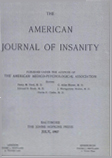Abstract
From the foregoing data, the following general principles regarding the cranio-vertebral dynamics may be drawn:
(1) The cerebrospinal fluid pressure directly follows either a change in venous pressure or a change in caliber of the cerebral vessels. It is only indirectly related to changes in arterial pressure. Thus, a rise in arterial pressure does not affect the cerebrospinal fluid pressure unless the venous pressure, as a result, becomes increased. The studies on postural alterations particularly stress the direct relationship between the cerebrospinal fluid and venous pressures. It may be stated that under ordinary physiological conditions, the venous pressure may be considered the chief factor in affecting the cerebrospinal fluid pressure. It is only under unusual conditions, such as severe metabolic disturbances or under such conditions set up by injections of hypotonic or hypertonic solutions, that osmosis plays an important rôle in changing the cerebrospinal fluid pressure.
(2) The cerebral blood flow is related to two important factors: (1) the arterial pressure, and (2) the caliber of the cerebral vessels. Thus, a rise in arterial pressure will result in an increased cerebral blood flow unless there is an associated over-compensating cerebral vasoconstriction. Again, cerebral vasodilatation will be associated with an increased blood flow through the brain, unless there is an accompanying marked fall in arterial pressure.
(3) During changes in posture from the horizontal to the up-right, there is a fall in carotid pressure which is kept within normal limits, probably mainly by the vasomotor system. Associated with this fall in pressure, there is a diminished cerebral blood flow and a greater uptake of oxygen per unit of blood by the brain.
(4) In individuals who have unstable vasomotor mechanisms or arteriosclerosis, the assumption of the upright position may throw an overwhelming burden on the circulation, so that the carotid pressure and cerebral blood flow fall abnormally. As a result, there is a cerebral anoxemia with production of cerebral symptoms, reaching their acme in syncope or in convulsions. The administration of vasodilator drugs, combined with upright tilting, may produce similar phenomena.
(5) The response of the cerebral circulation to the administration of drugs depends upon the complex pressure flow relationship between the cerebral and general circulation. Probably the most dramatic of the drugs used in this study was insulin. Not only do moderate to large doses of this drug deplete the sugar in the blood, but may also produce a cerebral anoxemia. That an actual cerebral anoxemia occurs during insulin hypoglycemia is indicated by the facts that although the blood flow through the brain is diminished, there is a diminution in the jugular arterial difference in oxygen content.
The above experimental data demonstrate the applicability in the human subject of the techniques of jugular and carotid punctures and the blood flow method devised by Gibbs. By these methods a great amount of information regarding not only the pressure conditions occurring within the cranio-vertebral cavity, but also regarding the metabolism of the brain may be obtained.

